Did you know frozen veggies might be better for weight loss than fresh ones? This fact challenges what many think about healthy eating. Frozen veggies are a great, easy choice for busy lives.
The 2020-2025 Dietary Guidelines recommend filling half our plates with fruits and veggies. But finding fresh produce can be hard. That’s where frozen veggies come in. They’re picked and frozen at their best, keeping nutrients and flavor.
Registered dietitian Roxana Ehsani says frozen veggies keep their nutrients well. They’re pre-washed, pre-cut, and ready to go. This makes it easier to stay on track with your weight loss goals. Tamara Hoffman, another dietitian, loves how they stay fresh in your freezer for months.
Fiber in veggies helps you feel full longer, which is great for weight management. You can eat big portions without worrying about calories. Eating half your plate with veggies means you eat less of high-calorie foods. This simple trick helps you lose weight.
Key Takeaways
- Frozen vegetables retain nutrients as well as fresh produce when frozen at peak ripeness.
- Pre-cut and pre-washed options save time and make healthy eating more convenient.
- High fibre content in vegetables promotes fullness and reduces overall calorie intake.
- Following the half-plate method with vegetables supports sustainable weight loss.
- Long shelf life reduces food waste and makes meal planning easier
- Low-calorie density allows for larger portions without exceeding daily calorie goals
Understanding the Nutritional Value of Frozen Vegetables
Many people believe that fresh vegetables are always superior to frozen ones. But that’s not true. Nutritious frozen veggies have the same vitamins and minerals as fresh ones. Freezing locks in nutrients, making them great for healthy eating.
Peak Freshness and Nutrient Retention
Farmers pick veggies at their peak and freeze them quickly. This seals in vitamins that might fade from fresh produce. Nutrient-rich frozen vegetables stay nutritious for months in your freezer.
Comparing Fresh vs. Frozen Produce Nutrition
Research reveals interesting facts about frozen and fresh veggies:
| Nutrient | Fresh Spinach (1 week old) | Frozen Spinach |
|---|---|---|
| Vitamin C | 35% retained | 80% retained |
| Folate | 50% retained | 95% retained |
| Beta-carotene | 40% retained | 90% retained |
Key Vitamins and Minerals Preserved Through Freezing
Low-calorie frozen foods keep essential nutrients like:
- Vitamin A for healthy vision
- Vitamin K for strong bones
- Potassium for heart health
- Iron for energy production
- Calcium for teeth and bones
The American Diabetes Association recommends frozen dark leafy greens. They are low in calories but rich in nutrients. Research in 2022 found they may fight inflammation and lower cancer risk.
Why Frozen Vegetables Excel for Weight Management
Frozen vegetables are great for losing weight because they’re full of nutrients and easy to use. They have lots of fibre and are portion-controlled, making them perfect for dieting. These foods help you eat healthy and reach your weight loss goals easily.
High Fibre Content for Satiety
Fibre is key to feeling full between meals. Most frozen veggies have over 3 grams of fibre per serving. This helps control hunger and lowers calorie intake. It also makes you feel full for hours.
Low-Calorie-Density Benefits
Frozen veggies are packed with nutrients but low in calories. You can eat more without going over your daily calorie limit. This way, you stay full and keep your calorie intake down for weight loss.
| Frozen Vegetable | Calories per Cup | Fibre (grams) |
|---|---|---|
| Broccoli | 30 | 5 |
| Cauliflower | 25 | 3 |
| Green Beans | 35 | 4 |
| Spinach | 20 | 3 |
Portion Control Made Simple
Frozen veggies come in pre-measured packages, making it easy to control portions. This helps you track your calorie intake and stay on track with your diet. Having these convenient diet foods on hand enables you to make healthier choices and maintain a consistent diet.
Top Frozen Vegetables for Weight Loss Success
Some frozen vegetables are better than others for weight loss. They are full of fibre, vitamins, and minerals but low in calories. Eating them helps you feel full longer, making it easier to eat healthy.
Broccoli: The Fibre Powerhouse
Frozen broccoli has 5 grams of fibre per cooked cup. It’s also packed with vitamins, minerals, and antioxidants. The fibre helps control hunger and keeps you full between meals.
Cauliflower: Versatile and Low-Carb
Cauliflower has 3 grams of fibre per cup and is great for low-carb diets. It’s rich in vitamin C and K, supporting your immune system and bones. Cauliflower rice has only 5 grams of carbs and 3 grams of fibre, making it a good rice substitute.
Spinach: Nutrient-Dense Superfood
Frozen spinach has 5 grams of fibre per cup and is very low in calories. It’s a nutrient powerhouse with iron, folate, vitamin C, and protein. It’s easy to add to smoothies, soups, and main dishes.
Green Beans: Protein and Fibre Combo
Green beans have 3 grams of fiber and 2 grams of protein per cup. They’re as nutritious as lettuce and celery, adding crunch and bulk to meals without extra calories.
| Vegetable | Fibre per Cup | Key Benefits |
|---|---|---|
| Broccoli | 5 grams | Antioxidants, vitamins |
| Cauliflower | 3 grams | Low-carb, vitamin K |
| Spinach | 5 grams | Iron, folate, protein |
| Green Beans | 3 grams | Protein combo, low calorie |
Convenience Factor: Time-Saving Benefits
Frozen vegetables are a game-changer for quick, healthy meals. They’re convenient diet foods that save you from hours of kitchen work. Unlike fresh veggies, they’re pre-washed and ready to cook in seconds.
Using weight management frozen options also saves time. Fresh greens like spinach spoil fast. But frozen veggies stay fresh longer, making it easy to add them to meals anytime.
Stocking your freezer with the right foods makes quick meals easy. Mix healthy frozen produce with lean proteins and grains for a balanced meal in minutes. Here are some quick meal ideas:
| Frozen Vegetable | Protein Pairing | Prep Time |
|---|---|---|
| Stir-fry blend | Grilled chicken strips | 10 minutes |
| Broccoli florets | Baked salmon | 15 minutes |
| Mixed vegetables | Turkey meatballs | 12 minutes |
| Spinach | Scrambled eggs | 8 minutes |
Batch cooking with frozen veggies is a huge time-saver. Make big batches of meals and freeze them in single servings. This way, you can avoid takeout and stay on track with your weight loss goals.
Budget-Friendly Weight Loss with Frozen Produce
It’s possible to save money and lose weight without giving up nutrition. Frozen vegetables are an excellent choice for those on a calorie-deficient diet. They offer the same health benefits as fresh produce but cost less, making healthy eating affordable for all.
Year-Round Availability and Pricing
Fresh produce prices fluctuate significantly throughout the year. Strawberries are much pricier in winter, and asparagus is expensive outside its short season. Frozen foods, on the other hand, stay affordable all year, so you can enjoy summer corn in January or spring peas in October without spending a lot.
Most stores sell frozen veggies at 50-70% off compared to fresh ones during off-peak seasons. This makes it easier to plan your meals without worrying about price increases ruining your diet.
Reducing Food Waste
A lot of food is wasted in America, with about 40% of it thrown away. Fresh spinach and butternut squash often go bad quickly. But frozen veggies don’t spoil, staying good in your freezer for months.
Registered dietitian Tamara Hoffman says frozen options make it easier to eat more veggies. They’re pre-washed and pre-cut, saving time and helping you use what you buy, stretching your budget further.
Cost Comparison with Fresh Alternatives
| Vegetable Type | Fresh Price (per lb) | Frozen Price (per lb) | Annual Savings |
|---|---|---|---|
| Broccoli | $2.49 | $1.29 | $62.40 |
| Bell Peppers | $3.99 | $1.89 | $109.20 |
| Green Beans | $2.99 | $1.49 | $78.00 |
| Cauliflower | $3.49 | $1.79 | $88.40 |
Buying frozen foods for weight loss meals can save a lot of money. You can use the saved cash for lean proteins or other healthy foods to complete your diet plan.
Creating Balanced Meals with Frozen Vegetables
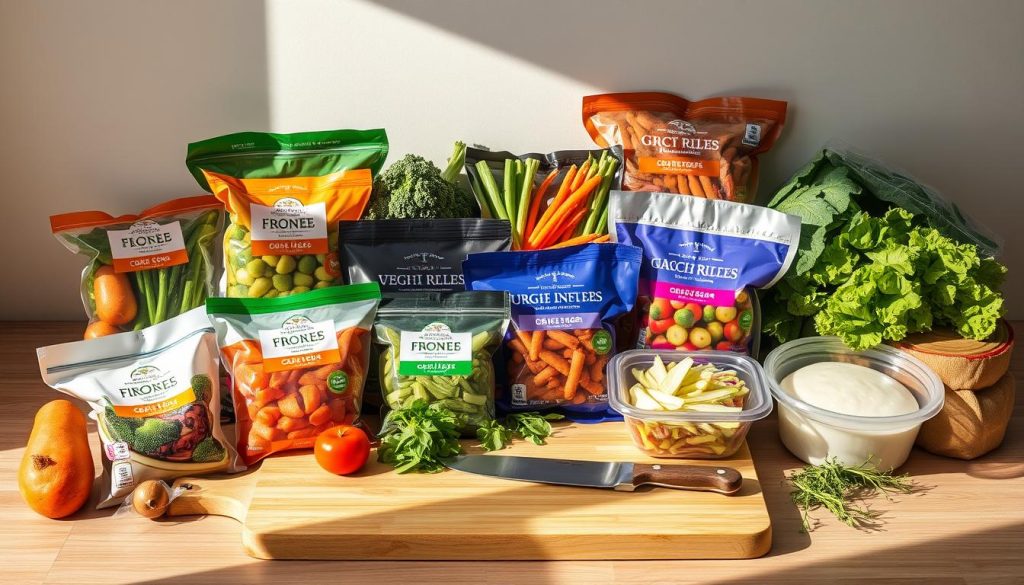
Using nutritious frozen veggies is key to managing weight. The 2020-2025 Dietary Guidelines for Americans stress the need for veggies in every meal. By mixing frozen options with other foods, you can make healthy, tasty meals.
Half-Plate Method for Weight Loss
The half-plate method makes meal planning simple. It suggests filling 50% of your plate with veggies. This ensures you get enough fibre and nutrients while cutting calories.
Fill half your plate with frozen veggies like broccoli, carrots, and peppers. The other half should be lean protein (25%) and whole grains (25%).
Protein Pairing Strategies
Turn frozen veggies into full meals by adding protein. Frozen stir-fry mixes become filling dinners with grilled chicken, shrimp, or tofu. These combos give you energy and help keep muscle mass while losing weight.
A balanced mix of protein and veggies keeps you full between meals. This reduces the urge to snack on unhealthy foods.
Building Satisfying Low-Calorie Meals
Creating satisfying meals doesn’t mean giving up taste or nutrition. Start with frozen meals, then add extra veggies for volume without additional calories. A side salad or fresh fruit adds to the nutrition.
Apps like Healthi can help track portions and suggest ways to add more veggies. This keeps your meals tasty and healthy.
Meal Prep Strategies Using Frozen Vegetables
Thoughtful meal planning turns frozen vegetables for weight loss into a lasting choice. Batch cooking saves time and keeps you on track with your health goals. The trick is to cook many servings at once and store them for the week.
Stocking your freezer with calorie-deficient meal prep is easy. Cook big batches of veggie soups, stews, or casseroles on weekends. Then, freeze them in single portions. This method reduces daily cooking stress and helps you avoid unhealthy choices.
Pre-portioned veggies make cooking easier. Stores now sell frozen spinach in cubes for smoothies or pasta sauces. Frozen onions and mushrooms are convenient diet foods that add flavour and nutrients without extra work.
- Dedicate Sunday afternoons to preparing 5-7 meal portions
- Label containers with contents and dates
- Keep a variety of frozen vegetable blends on hand
- Use silicone muffin cups to freeze individual vegetable portions
- Store prepared meals for up to three months
Digital tools help with meal planning. Apps like Healthi offer recipes and tracking for frozen veggies. They guide portion sizes and calories, helping you stay on track and enjoy different meals all week.
Special Frozen Vegetable Varieties for Diet Success
Making wise choices in healthy frozen produce can change your weight loss journey. New vegetable varieties let you cut calories while keeping meals tasty. They help you stay on track with your diet without feeling left out.
Riced Cauliflower as Rice Substitute
Riced cauliflower is a game-changer for low-carb diets. It has only 5 grams of carbs and 3 grams of fibre. This swap saves about 200 calories compared to white rice.
Your blood sugar stays steady, and you feel full longer. Use it in burrito bowls, as a stir-fry base, or as a side dish.
Stir-Fry Blends for Quick Meals
Pre-cut stir-fry mixes save time and boost nutrition. These nutrient-rich frozen vegetables include mushrooms, bell peppers, and onions. Each serving is packed with vitamins and low in carbs.
Cook them quickly with little oil for a complete meal. Add lean protein for a dinner ready in under 15 minutes.
Butternut Squash for Complex Carbs
Frozen butternut squash cubes make cooking easy. They’re full of beta carotene, vitamin C, and potassium. Their natural sweetness and fibre keep you full between meals.
Blend them into creamy sauces without heavy cream. This reduces saturated fat a lot.
Brussels Sprouts for Fibre Boost
Brussels sprouts have 6 grams of fibre per cooked cup. These low-calorie frozen foods are rich in vitamin C and antioxidants. Roast them straight from frozen for crispy edges.
Frozen kale is another excellent option. It has less than 1 gram of carbs per cup. It’s packed with iron, calcium, and vitamins A, C, and K.
Reading Labels and Choosing Quality Options
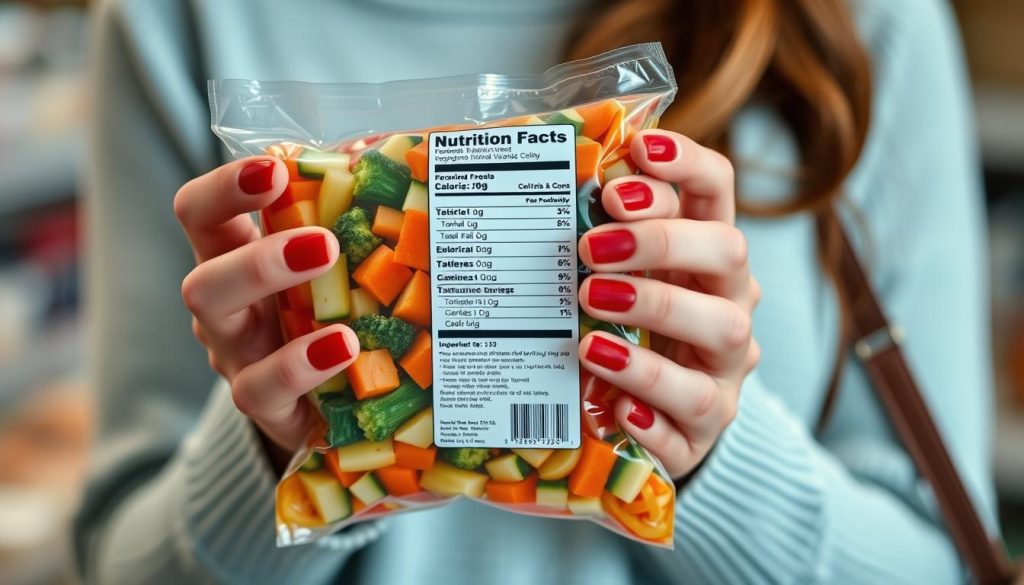
Smart shopping for *nutritious frozen veggies* starts with understanding package labels. Many shoppers think all frozen vegetables are healthy. But some packages have hidden ingredients that can ruin your diet goals.
The Nutrition Facts panel is key. Look at the ingredient list first—it should be short and straightforward. The best *healthy frozen produce* only lists the vegetable itself. Avoid packages with added butter, cheese sauce, or seasoning mixes. These can add a lot of calories and sodium to your meals.
- Sodium content should be under 140mg per serving
- No added sugars in the ingredient list
- Avoid “seasoned” or “sauced” varieties
- Skip products with artificial preservatives
Quality *weight management frozen options* include plain vegetables, unseasoned stir-fry blends, and single-ingredient bags. Brands like Birds Eye and Green Giant offer great plain vegetable options. Cascadian Farm provides organic choices without additives.
When building your freezer stock, mix different vegetables with lean proteins and whole grains. Plain frozen shrimp, grilled chicken strips, and brown rice are great with vegetables. This mix keeps meals exciting and supports your weight loss journey.
Cooking Methods That Maximise Weight Loss Benefits
The way you cook frozen veggies can really impact your diet. Using innovative cooking methods keeps nutrients high and calories low. This way, you can make tasty meals that help you manage your weight.
Steaming and Roasting Techniques
Steaming is great for keeping nutrients in frozen foods without adding calories. Just steam broccoli or green beans for 5-7 minutes until they’re tender-crisp. For roasting, toss Brussels sprouts with olive oil and roast at 425°F for 20-25 minutes until they’re golden and crispy.
Avoiding Added Fats and Sodium
Avoid pre-seasoned frozen veggies, as they can contain hidden calories and excessive sodium. Use cooking spray or vegetable broth instead of butter or heavy oils. When stir-frying riced cauliflower, use a hot pan and just a little oil to keep it low in fat.
Seasoning Without Extra Calories
Make your diet foods more flavorful without adding calories. Use fresh herbs like basil, oregano, and thyme for no-calorie flavor. Garlic powder, onion powder, and smoked paprika also add great taste. Here are some seasoning ideas:
| Vegetable | Zero-Calorie Seasonings | Preparation Method |
|---|---|---|
| Spinach | Garlic, lemon juice, black pepper | Steam 3 minutes |
| Cauliflower | Turmeric, cumin, cayenne | Roast 20 minutes |
| Green beans | Dill, mustard powder, vinegar | Blanch 5 minutes |
Common Mistakes to Avoid with Frozen Vegetables
Choosing the right frozen vegetables can help you lose weight. Many people unknowingly make mistakes that hinder their progress. Knowing these common errors enables you to get the most from nutrient-rich frozen vegetables and stay on track with your health goals.
Pre-Seasoned Varieties to Skip
Always check the ingredient labels when buying frozen vegetables. The best ones only list vegetables. Pre-seasoned options often contain excessive amounts of butter, oils, and salt. They can also contain sugar, fat, and salt, which can ruin your calorie-deficient meal prep plans.
Here are some bad choices to avoid:
- Breaded or fried vegetables (extra calories and unhealthy fats)
- Cheese sauce varieties
- Butter-flavored selections
- Asian-style sauces with high sugar content
Portion Size Misconceptions
Even healthy foods can lead to weight gain if you overeat. Frozen vegetables are low in calories, but overeating them can lead to weight gain. Some portion-controlled frozen meals may seem appealing, but they often lack essential nutrients like protein and fibre, which can lead to hunger soon.
| Vegetable Type | Recommended Portion | Common Mistake |
|---|---|---|
| Mixed Vegetables | 1-2 cups | Eating an entire family-size bag |
| Corn | 1/2 cup | Treating it as unlimited food |
| Peas | 1/2 cup | Not measuring portions |
Storage and Preparation Errors
Proper storage keeps frozen vegetables fresh. Don’t let them thaw and then refreeze, as it harms their quality. Avoid pre-made frozen dinners with hidden calories or preservatives. Instead, make your own healthy meals using plain frozen vegetables.
Conclusion
Frozen vegetables are a great way to lose weight without giving up on nutrition. They have the same vitamins and minerals as fresh ones. Plus, they’re always ready in your freezer.
They’re perfect for busy lives. You can quickly make a stir-fry with mixed veggies or add spinach to your smoothie. Brands like Birds Eye and Green Giant offer a wide range of options, from simple veggies to creative mixes.
Choosing the right frozen veggies helps you stay on track all year. Keep your freezer stocked with green beans, butternut squash, and Brussels sprouts. With smart shopping and simple cooking, you can make tasty meals that help you lose weight. Frozen veggies are your key to healthy eating.

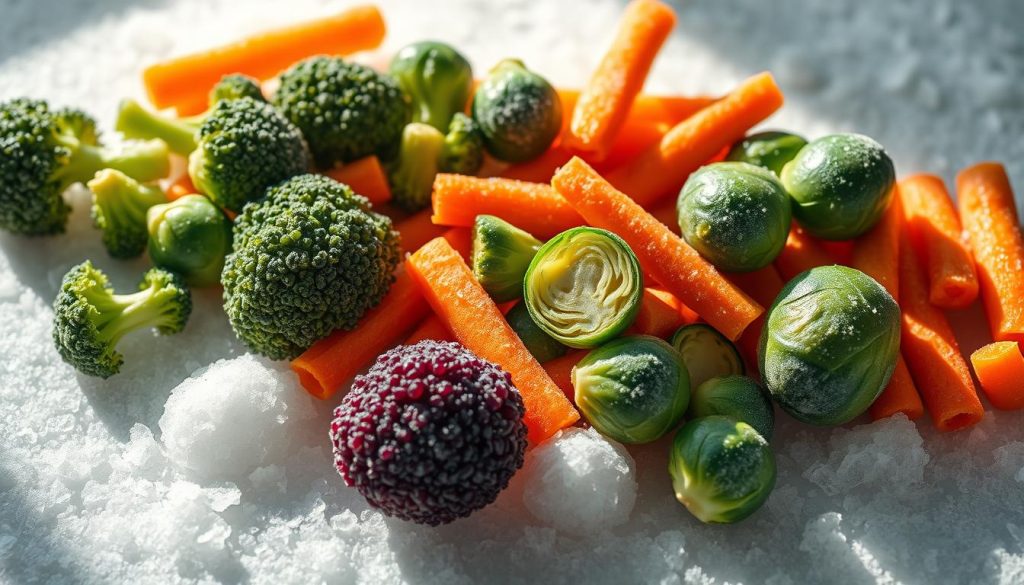
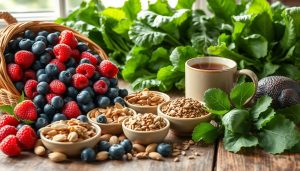
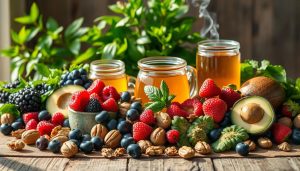
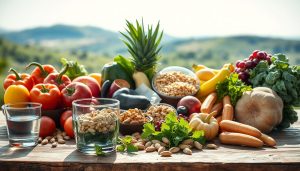



1 thought on “Frozen Vegetables for Weight Loss: A Healthy, Easy Solution”
https://shorturl.fm/FFMBv